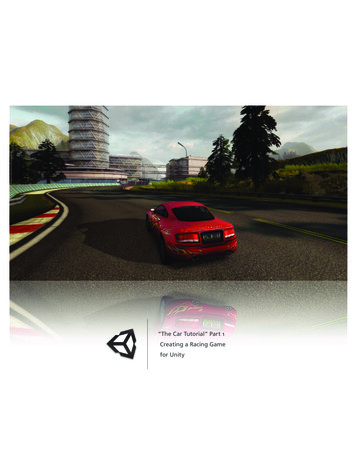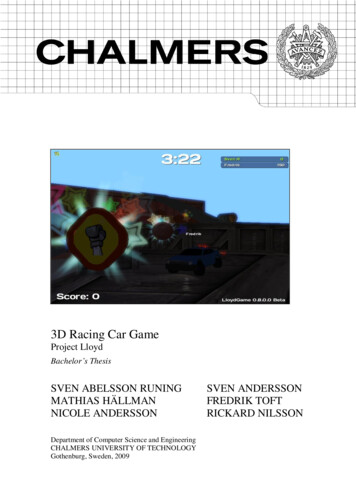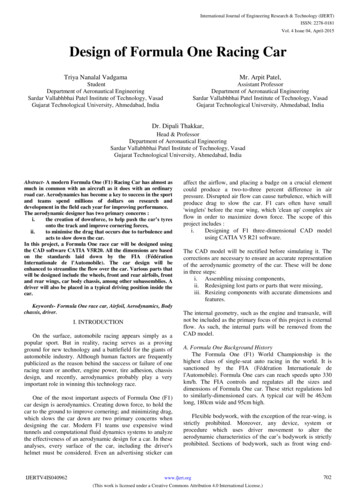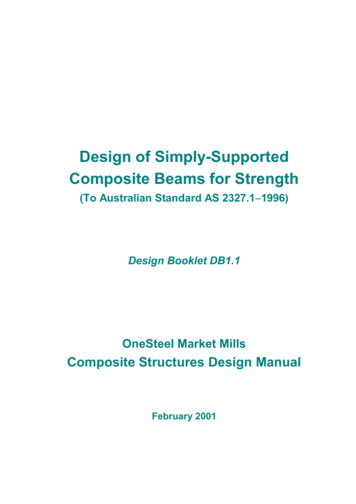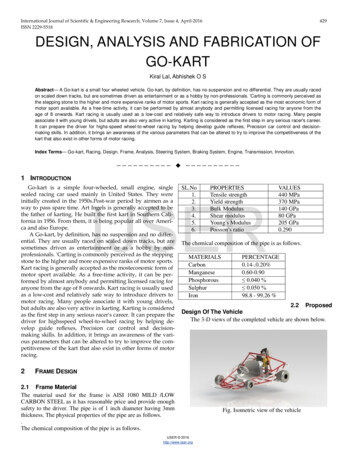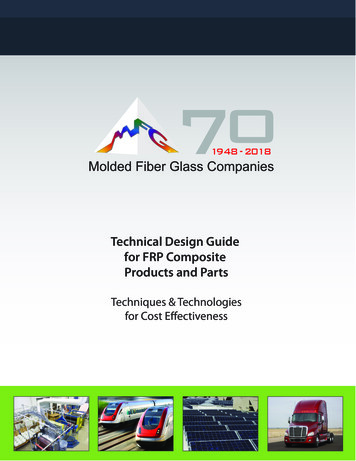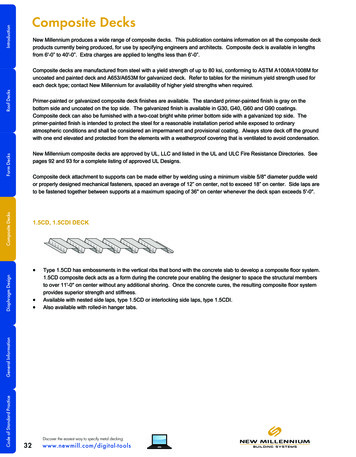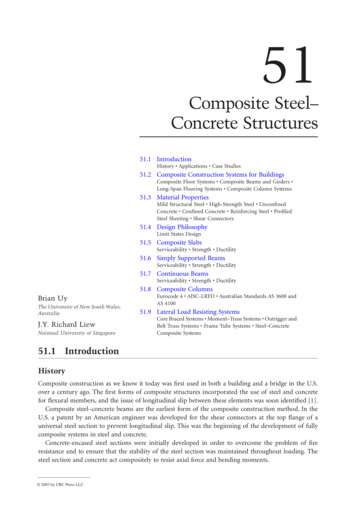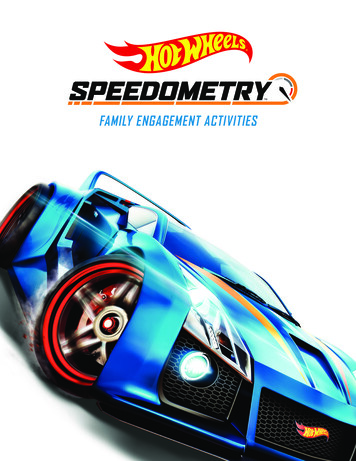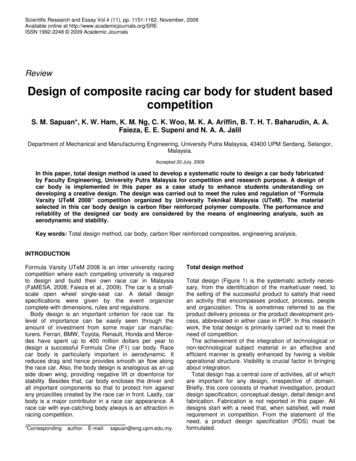
Transcription
Scientific Research and Essay Vol.4 (11), pp. 1151-1162, November, 2009Available online at http://www.academicjournals.org/SREISSN 1992-2248 2009 Academic JournalsReviewDesign of composite racing car body for student basedcompetitionS. M. Sapuan*, K. W. Ham, K. M. Ng, C. K. Woo, M. K. A. Ariffin, B. T. H. T. Baharudin, A. A.Faieza, E. E. Supeni and N. A. A. JalilDepartment of Mechanical and Manufacturing Engineering, University Putra Malaysia, 43400 UPM Serdang, Selangor,Malaysia.Accepted 20 July, 2009In this paper, total design method is used to develop a systematic route to design a car body fabricatedby Faculty Engineering, University Putra Malaysia for competition and research purpose. A design ofcar body is implemented in this paper as a case study to enhance students understanding ondeveloping a creative design. The design was carried out to meet the rules and regulation of “FormulaVarsity UTeM 2008” competition organized by University Teknikal Malaysia (UTeM). The materialselected in this car body design is carbon fiber reinforced polymer composite. The performance andreliability of the designed car body are considered by the means of engineering analysis, such asaerodynamic and stability.Key words: Total design method, car body, carbon fiber reinforced composites, engineering analysis.INTRODUCTIONFormula Varsity UTeM 2008 is an inter university racingcompetition where each competing university is requiredto design and build their own race car in Malaysia(FaMESA, 2008; Faieza et al., 2009). The car is a smallscale open wheel single-seat car. A detail designspecifications were given by the event organizercomplete with dimensions, rules and regulations.Body design is an important criterion for race car. Itslevel of importance can be easily seen through theamount of investment from some major car manufacturers. Ferrari, BMW, Toyota, Renault, Honda and Mercedes have spent up to 400 million dollars per year todesign a successful Formula One (F1) car body. Racecar body is particularly important in aerodynamic. Itreduces drag and hence provides smooth air flow alongthe race car. Also, the body design is analogous as an upside down wing, providing negative lift or downforce forstability. Besides that, car body encloses the driver andall important components so that to protect him againstany projectiles created by the race car in front. Lastly, carbody is a major contributor in a race car appearance. Arace car with eye-catching body always is an attraction inracing competition.*Correspondingauthor. E-mail:sapuan@eng.upm.edu.my.Total design methodTotal design (Figure 1) is the systematic activity necessary, from the identification of the market/user need, tothe selling of the successful product to satisfy that needan activity that encompasses product, process, peopleand organization. This is sometimes referred to as theproduct delivery process or the product development process, abbreviated in either case in PDP. In this researchwork, the total design is primarily carried out to meet theneed of competition.The achievement of the integration of technological ornon-technological subject material in an effective andefficient manner is greatly enhanced by having a visibleoperational structure. Visibility is crucial factor in bringingabout integration.Total design has a central core of activities, all of whichare important for any design, irrespective of domain.Briefly, this core consists of market investigation, productdesign specification, conceptual design, detail design andfabrication. Fabrication is not reported in this paper. Alldesigns start with a need that, when satisfied, will meetrequirement in competition. From the statement of theneed, a product design specification (PDS) must beformulated.
1152Sci. Res. EssaysFigure 1. Design Core (Pugh, 1991).Market investigationIn the real Formula One (F1) competition (2008 FormulaOne Technical Regulations, 2008), an automobile designned is solely for speed races on circuits or closedcourses. The performance of the cars is highly dependenton aerodynamics, electronics, suspension, tires anddriver skill. All the racing cars must strictly obey theFormula One Technical Regulation for safety reasons. Itseconomic effect is very large as millions of people watching races worldwide. The market is huge due to itsattractive racing event. Its high popularity brings to theinvestment of big company by the mean of technologyadvancement to improve the performance of car in allaspect. In this field, car body design is one of the mainconcerns in championing the circuit.Before starting the design of automobile, it is verycrucial for a designer to entirely understand the rules andregulation stated by organizer, Universiti Teknikal Malaysia Melaka. Cars (FaMESA, 2008) designed must complywith these regulations in their entirety at all times duringan event. Previous paper (Faieza et al., 2009) hasreported on the design and fabrication of the entire carbut the body was not design and fabricated due to timeconstraint. Therefore, this paper reported on the designof the car body.In this design, the car is entirely following “FormulaVarsity Technical Specification” provided by organizer(FaMESA, 2008). Rules are intended to give freedom andfair competition to the competitors in order to raise theinvolvement of undergraduates in the safety, researchand future development of car design. In this design, therules involve are material, weight, dimensions andbodywork. Material is a very important aspect for a carbody design. It is convenient to have a high strength andlow weight of material because it can enhance the safetyof driver and at the same time fulfill the requirement ofcompetition that restricts the weight of car. The materialselection process was conducted in selecting the mostoptimum material for the varsity car body but details onmethod of selected in not reported in this paper. In thatwork, carbon fiber reinforced polymer composite materialwas selected in fabricating the body of car due to itsoutstanding performance. In actual F1 car, carbon fiberreinforced epoxy composite is used in making car body.All the maximum dimensions and bodywork of car arestated clearly under the technical specification. Therelated requirement has been accomplished by thechassis construction. Therefore, the main concern bodydesign is left to the aerodynamics. Aerodynamics plays afundamental role in car performance. Aerodynamics isone of the most important factors of in the design of carbody. It mostly affects the overall performance of racingcar. The aerodynamics study of car can be learnt byreferring to the real F1 racing car (2008 Formula OneTechnical Regulations, 2008) and reference books. Itmakes the designs more reliable and feasible. Beside theperformance, aesthetic of the designed car also has to beconsidered. Its good appearance can carry a betterimage to the university and it can bring confident to thedriver during the competition.Product Design Specification (PDS)PDS is acting like a mantle enveloping the whole coreactivity. In order to establish a balance PDS, we need toencompass every major elements as they are the primarytriggers from which the PDS evolves (Table 1).Conceptual designConceptual design involves two stages of work as shownbelow:i) The generation of solutions to meet the stated need.ii) The evaluation of these solutions to select the one thatis most suited to match the PDS.There are different (creativity methods) used by designteams to generate ideas to find many conceptual designsolutions. These methods are:i) Brainstorming method.ii) Gallery technique.iii) Problem decomposition.iv) Morphology method.For this particular design, the gallery technique was usedto come up with the conceptual designs. Below is anexplanation on the gallery techniques:1. Problem introduction (more effectively advancenotification for more readings and preparation).
Sapuan et al.1153Table 1. Product design specification for formula varsity car body.Product design specificationFormula varsity car bodyDate: 24/09/2008Ref. No. RequirementsPerformance1.1 Aerodynamics11.2 Stability - downforce generation1.3 Engine coolingDimension2.1 Maximum height: 900mm22.2 Maximum width: 1500mm2.3 Maximum length: no constraintWeight33.1 Total weight: 140kgMaterial44.1 Carbon fiber4.2 Fire -resistant composite based on fiber glassStandards and Specifications55.1 Formula Varsity Technical SpecificationSafety66.1 Protection on driver6.2 Enclosure of interior componentsInstallation77.1 Easy and quick assemblyErgonomics88.1 Easy to aboardManufacturing Process99.1 Simple9.2 JoiningAesthetic1010.1 Shape10.2 ColourTarget Product Cost1111.1 Low fabrication cost11.2 Minimum maintenance cost2. Idea generation stage (each member work for his ownfor 15 to 20 min to generate solutions to the problem-noopportunity for criticism or discussion- ideas are externalize as text and/or drawings on papers).3. Association of ideas stage (all ideas are displayed, ideasare spared over large table- 15 to 20 min time is given fordiscussing ideas- seeking the promising compensations).At the end of this stage, new concepts may be generatedor just focusing on developing the already proposed.4. Idea generation stage 2 (each member works for hisown again to generate new ideas or to develop existingideas from the previous interaction. Stages 3, 4 can nowbe repeated if necessary.5. Idea selection (promising ideas are selected for furtherSheet: 01/01Rev. No.development).Solution generationIn order to generate ideas for body design, our teamhadvisited machining shop for several times to collectaccurate measurements of the chassis. Then, a 10 to 1scale engineering model of the chassis was drawn toprovide a basic platform for our body design. The masterdrawing was photocopied so that there are more chassismodels for the designers to design and draw new carmaking the body design process easier. Figure 2 illustrates the chassis model we drawn on an A3 paper while
1154Sci. Res. EssaysFigure 2. Sketch of chassis of varsity car.Figure 3. 3D solid model of the chassis.
Sapuan et al.1155Figure 4. First concept of design.Figure 4. First concept of design.Figure 3 shows the 3D solid model of the chassis.Concept 1This concept mimics the design of an aero plane wherethe vehicle nose is made in cone shape for aerodynamicspurposes. The tip of the nose was designed to be spherical to reduce drag and ensure smooth air flow. Eachcurving on the body was made as smooth as possible toreduce air resistance. The body does not cover the chassis up to the top section because it does not favor theaerodynamic aspect. Also, by building the body low helpsto reduce the car’s center of gravity. This concept doesnot involve many parts. Hence, it is easy to be fabricatedand installed (Figure 4).Concept 2This concept emphasizes on driver’s safety, it covers thedriver from bottom to the top of the chassis. A windscreenis included in the design to allow clear view for driver.This design is considered revolutionary. It has severaladvantages that other designs do not have. This conceptutilizes minimum material at the same time providemaximum protection to the driver. Using less material isan advantage in racing as it reduces weight and allowshigher speed and reaction for the race car. It isconsidered as the easiest one to be fabricated due to itssimplicity (Figure 5).Concept 3Concept 3 (Figure 6) is designed by benchmarkingFormula One’s standard. It has front wing, side pod, realwing and diffuser. These components not only designedfor aerodynamics purposes, they also provide downforcefor stability. This design reduces the car’s center ofgravity to the minimum. Hence, further improve its stability. In safety aspect, these wings protect driver duringbody. Besides, photocopied drawings are inerasable,collision from every directions.Evaluation and selection of conceptThere are ten criteria to be concerned in the effort todetermine the best selection of design concept:1. Aerodynamics2. Stability3. Weight4. Safety5. Fabrication6. Installation7. Ergonomic8. Cost9. Engine cooling10. AestheticWeighting method is used to determine the relativeimportant of the selected criteria. This method is used to
1156Sci. Res. EssaysFigure 5. Second concept of design.Figure 6. Third concept of design.
Sapuan et al.1157Table 2. Application of digital logic method to criteria of car icationInstallationErgonomicCostEngine tSafetyFabricationInstallationErgonomicCostEngine coolingAesthetic11021314151610Decision 19200Decision number21 22 23 24 2501111102627282930111111100000000010000Table 3. Weighting factor for criteria of car icationInstallationErgonomicCostEngine coolingAestheticTotalPositive decision975832225245enhance the selection process to carry out the mostoptimum design.Total number of decision N (N – 1)/2.In this case, total criteria to be considered is 10, thereforeN 10.Therefore, total number of decision 10 (10 – 1)/2 45Weighting 1110.0441.000.Then, the table is tabulated to find out the positivedecision number of each criterion as shown in Table 2.Table 3 and Figure 7 show weighting factor for criteriaof car body. From Table 3, it is obvious that aerodynamics is the most important criteria in designing car body.It is followed by safety, stability, weight, engine coolingand fabrication. Installation, ergonomic, cost and aesthetic is the least important in this analysis.Table 4 shows the evaluation process of the concepts
1158Sci. Res. EssaysFigure 7. Weighting factor of criteria.Table 4. Conceptrating.Concept 1No.12345678910Concept rating (1 as lowest, 5 as highest)Concept 2Concept ionInstallationErgonomicCostEngine 0.4440.1333.622Normalrating3254553532developed. Based on the concept evaluation above,Concept 3 was selected as it scores the highest ratingamong three conceptual designs. Hence, Concept 3 isanalyzed further in the sub-following 0.1330.4440.2223.933extensive analysis is performed on the selected conceptof car body. With the help of clear visualize of drawing,the analysis can be carried out in better way. Theanalysis is conducted by evaluating several importantparts of the car body designed.Analysis on the selected designThe detail drawing of the selected conceptual design isdeveloped with the aid of CATIA software. Figures 8 and9 are the detail drawings of car concept 3. In this section,Front WingThe front wing is vital in the design as it is the first part ofthe car contacting with the air. The purpose of the design
Sapuan et al.1159Figure 8. Three dimensional view of car body designed.Figure 9. Multiple view of car body designed.is trying to minimize the resistant of air flow on the car asshown in Figure 10. The fast incoming air flow is deviatedto other direction through the smooth surface of frontwing (white arrows represent the direction of air flow).The airflow passes above and beneath the wing ratherthan around it. By this way, the unwanted drag can beminimized effectively.The objective of the design is also trying to generate as
1160Sci. Res. EssaysFigure 10. Air flow on front wing.Figure 11. Downforce created due to incoming force of air.Figure 12. Air flow on nose.much downforce as possible to stabilize the fast movingcar. It is primarily important when taking into account thesafety aspect of the car. The front wing plane is made withnearly complete width of the car which can allows moredownforce to be generated at the front. In this design, thedownforce is generated as shown in Figure 11. By usingthis design, the best compromise between the greatestpossible downforce and the lowest possible air resistancecan be accomplished.The endplate of front wing is designed by purpose tosplit the air flows to other sides so that it does not hit onthe front wheels. It overcomes the main problem ofturbulence around the wheels. The turbulence generatedreduces aerodynamics efficiency and contribute toundesired drag that may down grade the overallperformance of car.NoseThe major significant factor in designing nose is frictiondrag. The flow air passes through above and aside of thenose without creating turbulence force. The surfacesmoothness of nose must very good so that less resistantand drag force will act on it. The flow of air on nose isshown in Figure 12. The design of nose should be madeas low as possible to generate more downforce. Generally, the nose itself does not generate much downforcebut in term of ergonomics, lower noses may have goodvisibility from the driver's point of view.The other main purpose of nose is to protect the driver.It must comply with several strength and measurementrules that are set by organizer. Nose is functioning as thefrontal energy absorbing structure which is able to absorbenergy in the case of a head-on collision. It is one of thereasons for choosing carbon fiber reinforced compositematerial to construct car body.Side podThe air that passed through the nose is then guided tothe side of the car by the splitter located just in front of theside pods. The design of side pod can smoothen out theair flow that has been disturbed by front wheels. It separates the flow into two parts; one is directed into the side
Sapuan et al.1161Figure 13. Air flow on side board.Figure 14. Air flow on real wing.side pod and other is diverted outside as shown in Figure13.The air passes through the smooth surface of side podwith minimum drag force. It acts to block the air flow fromhitting the rear wheels. The direct hit of air on the wheelsmay create turbulent which disturbs the whole air flowdynamics on the real part of car. The design makes theair flows in steadier ways. Besides, the installation of sidepod increases the safety of the car. It is able to stabilizethe whole body of car and protects driver from sidecollisions.Air directed into the side pod is used to cool the engine.It acts like a radiator intake. This design is essential toenhance the performance of engine and protect it fromoverheating.Top and bottom rear wingThe rear wing is a crucial component for the performanceof a race car. It creates the most drag on the car. Trailingvortex or induced drag is the dominating drag on rearwings. There is about one third of total down force comesfrom the rear wing. The wing angle designed is decidedcarefully because more wing angle increases thedownforce and therefore produces more drag, thusreducing the cars top speed.In this design, two rear wings are assembled on the caras shown in Figure 14. The rear wings are used to createdownforce and stabilize the car. In usual condition, thefront wing is producing much more downforce than thereal wing. It makes the front tyres of car much heavier athigh speed. If such situation happens, it is very hard tocontrol the movement of the car. Therefore, two realwings are installed in the design to make it safer to becontrolled and increase its stability in high speed.Beside creating downforce, the bottom rear wing canwork as a diffuser. It is used to guide and control airflowunderneath the car. It works to increase the speed underneath the car. The air flow moves at higher speed belowthe car and it lowers the pressure on it. Therefore, higherpressure above the car pulls the car down to the track. The
1162Sci. Res. Essayssuction effect is a result of Bernoulli’s theory.ConclusionFrom the outcomes at the end of this design andfabrication planning, there are a few highlights that canbe considered as meeting the objectives and gainingvalues. The initial idea was to find out if there is analternative in producing a Formula Varsity race car body.As total design method is carried out throughout thewhole design and planning process, it is believed that thisproposed alternative can lead to a better product in a fewdifferent perspectives and this is supported by the figuresand conceptual analyses included in the design andplanning process.It is proven that the final product had added value tothe race car. As discussed in the detail design section, theFormula One analogous design had given the car betteraerodynamic properties and stability. Besides, the use ofhigh strength fiber reinforced composite material improves the race car safety factor. This is a plus point assafety is an important criterion in motor racing. Also, substantial weight reduction is achieved when the car body isfabricated using composite material as this material is lowin density.ACKNOWLEDGEMENTSThe authors wish to thank University Putra Malaysia forfinancial support. The help of Mr Dandi Bachtiar ofFaculty of Engineering, Universiti Putra Malaysia inimproving the quality of Table 4 is highly appreciated.REFERENCESFaieza AA, Sapuan SM, Ariffin MKA, Baharudin BTHT, Supeni EE(2009). Design and fabrication of a student competition based racingcar, Sci. Res. Essays, 4 (5): 361-366.FaMESA (2008). Persatuan Pelajar Kejuruteraan Mekanikal (FaMESA),Universiti Teknikal Malaysia Melaka, Malaysia, Brochure.Formula One Technical Regulations (2008). http://www.f1-live.com/f1/img/regulations/ 2008tech en.pdf.Pugh S (1991). Total Design, Addison Wesley Ltd., Wokingham, UK.
Body design is an important criterion for race car. Its level of importance can be easily seen through the amount of investment from some major car manufac-turers. Ferrari, BMW, Toyota, Renault, Honda and Merce-des have spent up to 400 million dollars per year to design a successful Formula One (F1) car body. .
